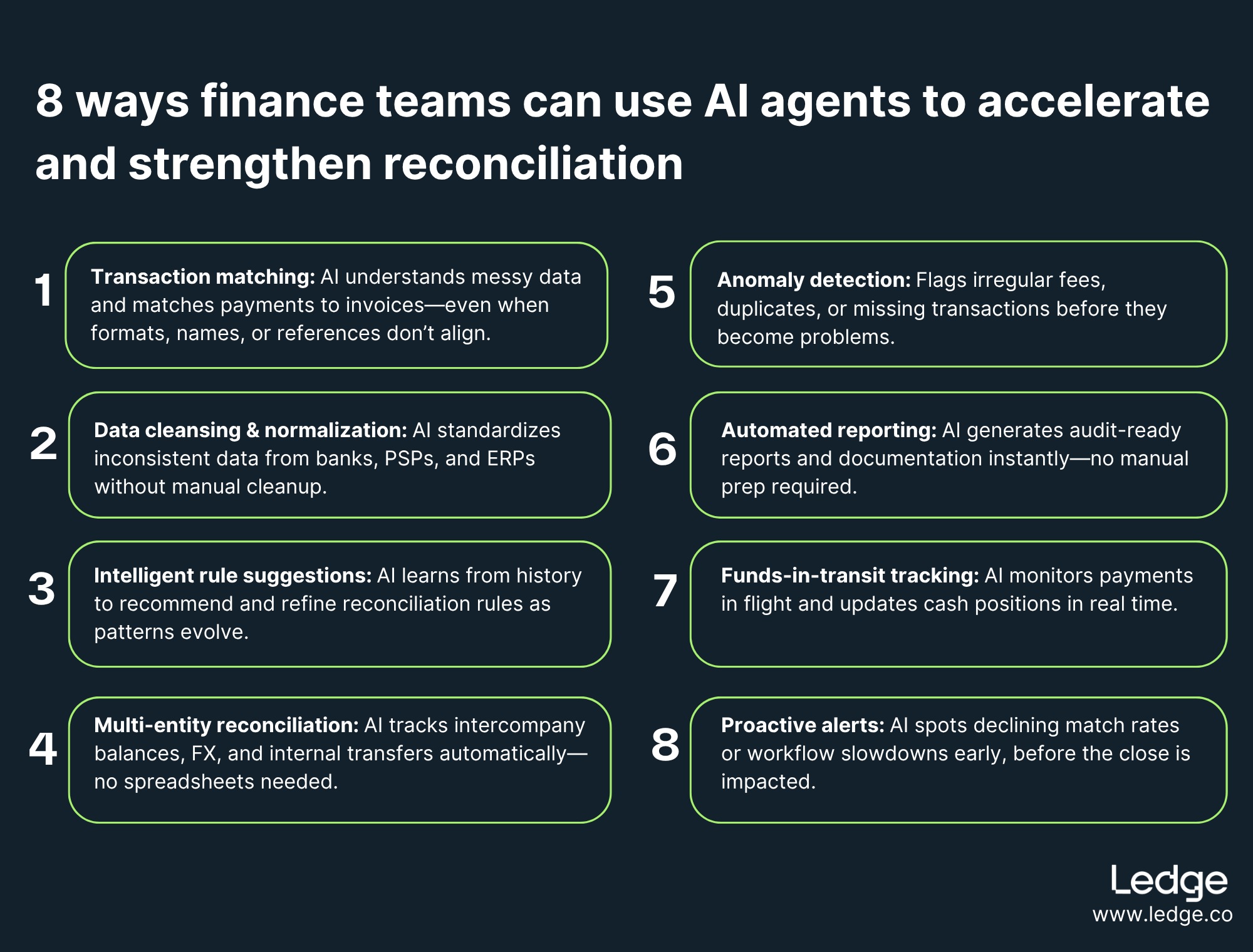AI reconciliation is a game-changer for scaling finance team capacity without adding headcount.
AI models are now sophisticated enough to reconcile financial data with speed and accuracy at scale. Large Language Models (LLMs) can handle unstructured data from banks, payment processors, billing systems, and databases. The technology is capable of addressing edge cases, exceptions, partial matches etc. that don’t match structured records 1:1.
Reconciliation is an important place to start integrating AI into your finance operations.
Here are 8 specific AI reconciliation workflows that are possible to accomplish with Ledge.

1. Automate transaction matching
(Rather than spending hours manually cross-referencing transactions across multiple sources and platforms)
The challenge: When reconciling transactions, it’s par for the course that finance teams will encounter inconsistent transaction descriptions, missing references, and variations in data formats across different systems.
This can make reconciliation an absolute nightmare, requiring you to roll up your sleeves and dive into the weeds, manually searching for the unique identifiers or hidden clues that explain each discrepancy.
How Ledge solves this: Ledge’s LLM-powered platform improves transaction matching by understanding and interpreting high volumes of complex, ambiguous, and unstructured financial data. AI relies on contextual clues and patterns to handle common scenarios such as:
- If a wire memo uses shorthand (e.g., “INV1234–6,”) Ledge’s AI can infer this refers to three invoices - 1234, 1235, and 1236, and can apply the payment accordingly
- If the payer name in a bank transaction differs from the ERP record, whether due to a naming variation, alias, or subsidiary relationship, Ledge’s AI uses historical behavior and metadata to confidently match and apply the payment
- If the payment hits the bank with no invoice reference or customer ID, but the remittance advice is sent separately via email or attachment, Ledge’s AI can parse the inbox, extract that context and invoice data, and match the payment automatically
2. Streamline data ingestion, cleansing, and normalization
(Instead of correcting endless formatting issues to standardize data from your PSPs, banks, and billing systems)
The challenge: Finance teams often deal with vast amounts of unstructured and inconsistent data from multiple sources such as banks, payment service providers, billing systems, and internal databases.
Before reconciliation even begins, teams are forced to manually clean, map, and normalize this messy data, which is filled with errors, inconsistencies, and varying formats, rendering ingestion and processing a time-consuming and error-prone process.
How Ledge solves this: Ledge uses AI-powered automation to streamline ingestion, standardization, and matching across messy, high-volume data sources. The Ledge platform”
- Parses memo fields and free-text descriptions to extract relevant financial identifiers
- Normalizes inconsistent field formats across banks, payment processors, and internal systems
- Maps disparate fields into a unified schema to support downstream reconciliation
- Flags potential duplicates or outliers based on historical patterns
- Resolves context gaps using historical mappings and metadata, reducing the need for manual cleanup
Ledge doesn’t modify source data, instead it overlays intelligence to ensure the reconciliation process can proceed without manual manipulation.
3. Unlock intelligent rule suggestions
(Rather than trying to remember if a transaction should be split across cost centers or chasing complex rules for partial payments)
The challenge: Reconciliation often relies on a complex set of matching rules to identify corresponding transactions across different systems. Creating and maintaining these rules manually is labor-intensive and requires not only deep domain expertise, but also familiarity with your company’s specific processes, naming conventions, and historical patterns.
Moreover, static rules may not adapt well to new transaction patterns or exceptions, leading to increased mismatches and exceptions that need manual review.
How Ledge solves this: Ledge’s platform uses AI to assist with rule creation by analyzing historical transaction behavior and match outcomes. Instead of requiring finance teams to manually define every rule from scratch, Ledge:
- Surfaces recommended rules based on patterns in past reconciliations (e.g., frequent matches using a specific memo format or amount range)
- Highlights attributes that consistently lead to successful matches or unresolved exceptions
- Suggests refinements to existing rules as transaction patterns change
- Learns from manual overrides and user input to improve suggestions over time
By leveraging AI for rule suggestions, finance teams can improve match rates, reduce manual interventions and tribal knowledge to manage reconciliation logic, and keep their reconciliation processes agile and up-to-date.
4. Scale multi-entity reconciliation
(Instead of manually tracking intercompany flows and due to/due from balances across spreadsheets)
The challenge: Reconciling transactions across entities, especially when FX, internal transfers, or shared payment processor accounts are involved, it is rarely straightforward. Teams often rely on messy spreadsheets just to understand whether internal transfers are booked correctly and track intercompany payments that often don’t align cleanly in timing or format.
How Ledge solves this: Ledge uses a combination of automation and AI to streamline multi-entity reconciliation. The platform:
- Matches transactions across entities, even when names, currencies, or formats differ
- Identifies and flags imbalances in intercompany flows
- Suggests or auto-generates intercompany journal entries with proper metadata and audit trails
- Maintains clean due to/due from accounts throughout the month, not just at close
The result: scalable, auditable multi-entity reconciliation that doesn’t require a manual spreadsheet to manage internal financial hygiene.
5. Uncover and troubleshoot anomalies
(Instead of trying to spot a one-off fraudulent charge or manually tracking down why a PSP suddenly charged you an unexpected fee)
The challenge: Discrepancies happen in the reconciliation process all the time, whether it’s one-off errors, fraud, or systemic issues like unexpected fees or tax discrepancies. While manual reconciliation processes can detect these issues, the pressure is still on finance teams to explain why the discrepancies occurred, leading to lengthy and often tedious investigations.
How Ledge solves this: Ledge’s AI continuously monitors reconciliation activity to detect and group anomalies — so teams can troubleshoot faster. For example:
- AI can detect that a series of unmatched transactions share common attributes, such as all being related to a specific customer or occurring on the same date.
- If reconciliation rates drop, AI can analyze exceptions and identify that many are due to new service fees introduced by a payment processor.
- AI can anticipate potential anomalies by learning from historical data, alerting teams to transactions that deviate from expected patterns.
By highlighting discrepancies earlier and in context, Ledge helps finance teams resolve issues faster, without relying on manual spreadsheet reviews.
6. Automate report generation
(Rather than painstakingly extracting data from multiple systems, formatting it into custom templates, and then triple-checking for errors or missing figures)
The challenge: Generating detailed financial reports and audit artifacts from reconciliation data is a critical but labor-intensive task. Each stakeholder requires working papers in specific formats with precise data presentations.
Manually compiling these reports is time-consuming and increases the risk of errors or inconsistencies, which can lead to compliance issues or misinformed decision-making.
How Ledge solves this: Ledge uses AI to continuously document and structure reconciliation activity as it happens. Every transaction matched, exception routed, or journal entry created is logged automatically, with full context. Ledge’s AI-assisted reporting capabilities automate the generation of customized reports by pulling data from various sources and presenting it in the desired format. Instead of stitching together data from multiple systems, finance teams get::
- Auto-generated audit trails showing how each match or resolution was reached
- Auto-updated reports with filterable views of match status, exceptions, and actions taken
- Exportable data ready for auditors, compliance reviews, or internal controls
- A single source of truth, eliminating the need for spreadsheet reconciliation or after-the-fact reportingAutomated reports can be refreshed instantly as new data becomes available, ensuring that all information is up-to-date.
AI ensures that audit artifacts aren’t a separate task, they’re a byproduct of how reconciliation is done. The result: faster prep, stronger documentation, and fewer compliance fire drills.
7. Track funds in transit and improve cash clarity
(Instead of waiting days to confirm whether large payments have cleared or been applied)
The challenge: In high-volume environments, it’s hard to know at any given moment how much cash is truly available. Payments may have been initiated but not received, received but not applied, or stuck in exception queues. These gaps make it difficult to forecast with confidence or answer basic questions like: “How much cash is actually usable today?
How Ledge solves this: Ledge’s AI-powered reconciliation engine doesn’t just match transactions; it continuously interprets new data, flags discrepancies, and updates your cash position in real time. That means you’re never waiting on a manual check or a month-end batch process to understand where your money is. With AI surfacing insights as they happen, finance teams get a live view of what’s cleared, what’s in flight, and what’s at risk of delay. Specifically, Ledge:
- Continuously reconciles payments, bank transactions, and open invoices as new data flows in
- Surfaces unapplied or unmatched funds instantly, including those lacking identifiers, with full context for faster resolution
- Tracks the movement of cash across entities, accounts, and processors, giving you visibility into what’s received, what’s still in transit, and what’s delayed
This real-time intelligence is powered by a combination of rules-based automation and AI, reducing the lag between when a transaction happens and when it’s confidently reflected in your cash position.
8. Stay ahead of reconciliation trends
(Instead of realizing too late that a key account hasn’t been reconciling properly for days)
The challenge: In most reconciliation systems, finance teams only catch issues reactively — once reports are already delayed, exceptions have piled up, or leadership asks why numbers aren’t matching. There's little visibility into emerging risks, workflow slowdowns, or declining match rates until it's too late.
How Ledge solves this: Ledge uses AI to continuously monitor reconciliation health across your stack — identifying not just one-off anomalies, but shifts in performance and patterns that require attention. Teams get proactive alerts when:
- Match rates drop significantly across a bank, Payment Processor, or business entity
- Exception volume surges for a specific transaction type (e.g., refunds or intercompany transfers)
- Reconciliation timing slows down or deviates from historical norms
These AI-powered insights help controllers, accountants, and finance leads catch risks early, address them before the close is impacted, and operate with far greater visibility into the health of their reconciliation workflows.
AI transforms the reconciliation process
AI not only handles the heavy lifting of data processing and analysis but also provides valuable insights that drive strategic decision-making, ultimately contributing to a more agile and resilient financial function.
With AI taking over repetitive tasks and reducing human error, finance teams can focus on higher-value work like identifying growth opportunities, mitigating risks, and optimizing financial strategies. The result is not just faster reconciliations but smarter, data-driven decision-making that strengthens the entire organization.
Curious to learn how Ledge actually works? Let’s walk you through it. You can schedule a demo to get started.












